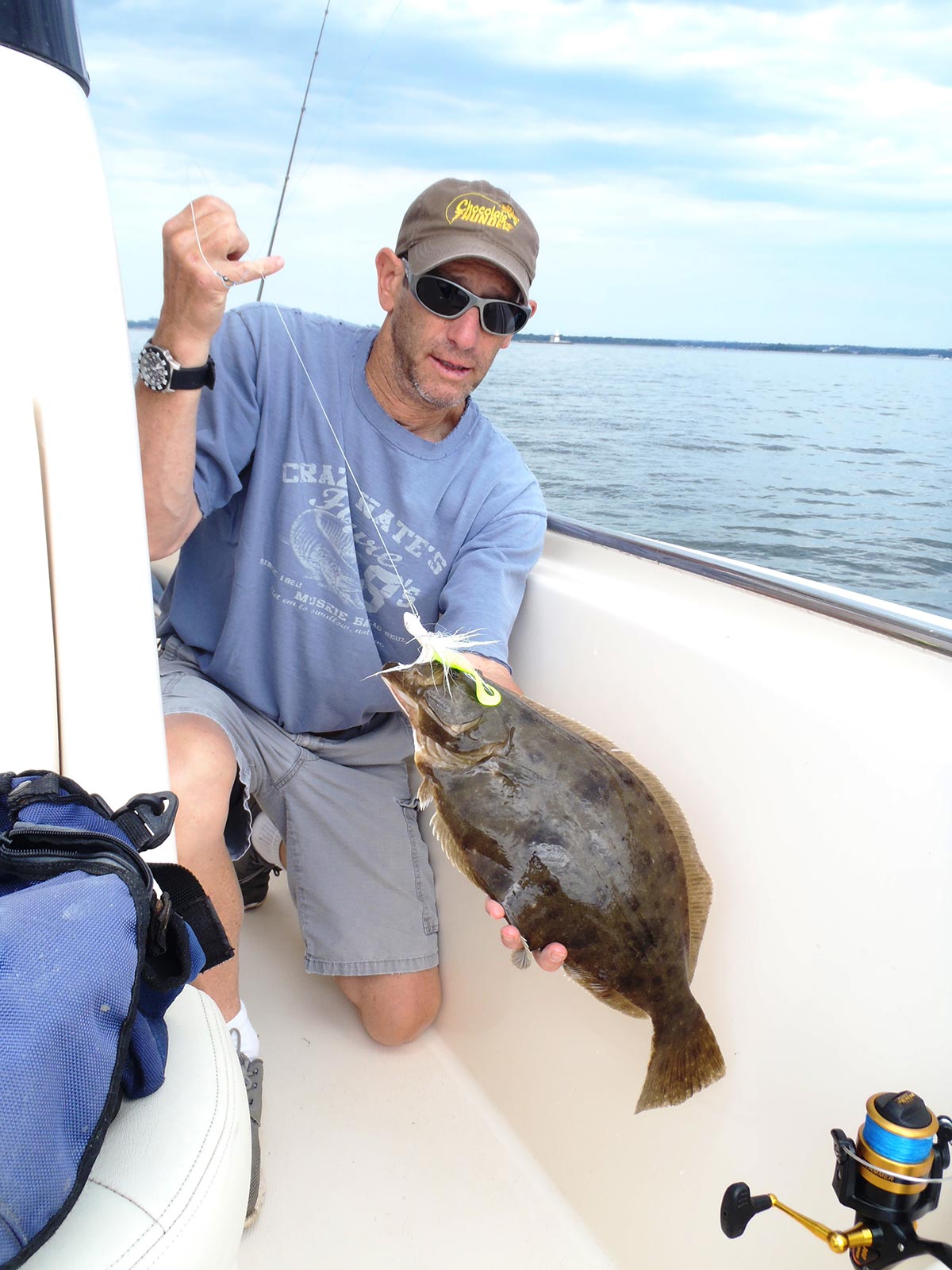There’s no doubt that the August full moon offers western Sound anglers a great chance for a doormat.
Hart Island is one of the larger islands in the Western Sound and is located straight across from the mouth of Manhasset Bay. It’s a diverse place structurally. There are flats on the south side of the island that offer some decent current, but on the west end is a rocky point and slightly off that point the bottom drops off significantly.
On the east end of the south side there’s another drop off with a steeper angle. Along the northwest shore there are clusters of boulders, where we’ve enjoyed chunking for stripers and blues. Beyond this point is a more rugged bottom including a minefield of rocks, rock clusters, and boulders. These waters are dangerous and should only be approached with extreme caution.
Three Areas
The best fluking is found along the south shore of the island, where there is plenty of room to fish, even on weekends. Let me describe the three primary locations in detail. The southeast corner is a flat that sports good current and drops off sharply from10 to 32 feet near a green buoy. At times the fishing can be very good here, but fishing it properly requires short drifts, because once your baits are on the flat bottom of the drop-off, bites stop. Similarly, there’s a point on the southwest corner with a prominent jetty and current. Here, the bottom drops off more gradually from 10 to 35 feet in several directions and longer drifts are possible and productive.
Between these two ends is a gentle cove that embraces a large flat. An angler can make long drifts in this cove because fluke schools spread out at different depths throughout the breath of the cove as they follow bait schools. The typical drift depths are from 6 to 20 feet. Years ago it was difficult to drift through some parts of the flat because of all the lobster pots, but in recent years the decline in lobsters has also seen a decline in the pots. However beware, there are still a few unmarked ghost pots scattered about and they represent formidable snags.
Bait Related

It may be obvious, but runs of fluke around Hart Island depend upon the abundance and location of bait. Although huge schools of sand eels roamed the entire Sound in the past, more recently the sand eel schools have been sparse. Since squid swim down the Sound in search of sand eels, fewer sand eels also means fewer squid, and it’s the squid that draw lots of big fluke west in spring. We have had some years with an abundance of peanut bunker and those peanuts grew all summer and were ripe for picking by fluke in August. Typically the August fish are larger on average than spring run fish. Some of the biggest fluke I have seen caught in the western Sound were caught around the full moon in August.
Although a persistent fluke fan can catch fluke from May into autumn around Hart Island, my friends and I prefer to invest our spring and summer fishing hours chasing stripers, blues, porgies and sea bass. However, a solid August run still occurs with regularity thanks to a combo of some peanuts, young of the year snappers, weakfish, and porgies that begin to leave the safety of the harbors and move into the Sound. As a result, nowadays we do most of our fluking around the August full moon. We concentrate our efforts at the western and eastern drop-off areas that often produce the larger specimens.
Weather
I don’t like to drift for fluke when it’s windy because it’s too difficult to control drift speed and direction, or make good presentations. Since I prefer to fish with the lightest possible bucktails for the best sport, I also prefer a leisurely drift. For private boaters who are still dragging sinkers and baited hooks around I have some advice – fish with bucktails! I strongly suggest you stop being stubborn and start having more fun with fluke. Also, bigger fluke are more likely to attack a bucktail with enthusiasm compared to a long leader baited hook.
Anyway, I prefer relatively quiet days for our fluke excursions. However, the island does knock down strong northerly winds and since we fish relatively close to the Hart Island shoreline, we sometimes are able to manage the wind and hence our drift speed.
Tackle
Both spinning and baitcasting gear will get the job done, but I prefer a baitcasting outfit because it is much easier to raise and lower the bucktail, and I have a much better feel for the bottom and hits. I match the reel to a 6-foot, 6-inch medium light rod. Twenty-pound test Sufix Performance Braid is my line preference along with a 30-pound test leader. Fluke are sometimes very finicky, and since I believe my tackle provides a more sensitive feel, it gives me a small advantage that improves my success.
I prefer to use the lightest bucktail possible. Although it’s true that in the deep fast waters off Montauk and in the ocean, stout tackle and bucktails as heavy as 6 ounces may be needed to catch fluke, in the much shallower waters around Hart Island meaty gear just isn’t needed. Typically we drift in water that’s 8 to 25 feet deep and a 1-ounce white bucktail is my usual choice. With a light bucktail, I can produce a much subtler presentation that often makes a difference. If the fish stack up in slightly deeper water I move up to an ounce-and-a-half bucktail.
Technique
Bucktailing is very interactive because the angler is always engaged, and therefore it’s a lot more fun. The best approach is to “wiggle” the bucktail along the bottom, not jig it dramatically. From my observations, some anglers believe bucktailing for fluke is akin to jigging for bass and blues. Do not make exaggerated up and down jigging movements. Instead, use consistent fast short bounces about an inch off the bottom.
Observations of feeding fluke reveal that the fish lift up on their side fins and look for motion or puffs of sand. When they spot activity they charge over to the location and then either flop on the bait to cover it, or snap at it. Fluke flop on prey to prevent it from sprinting away, and they snap at it to get a grasp with their teeth. Yes, there are days when competition is very intense, and on those days fluke quickly engulf the prey. An angler can sense these intense feeding periods because the hits are consistently hard and quick. Set the hook sharply and quickly when a “thump” is felt during intense feeding periods. However, intense feeds are short, so make the most of them.
Most of the time fluke are less competitive and feed in a more leisurely way. Often instead of a definite “smack,” fluke seem to prefer to control the prey first by flopping on it, and eat it second. When I feel weight without a thump I pause my bouncing and wait a second or two. If I feel a thump, I set the hook. On the other hand, if I continue to feel only weight I presume the fluke has flopped on the bucktail. I lower the rod tip slowly, allow tension to return to the line, and then wait for the hit, hoping the fluke has uncovered the prey and gobbled it up. I’ll repeat this process until either the fluke swims off or engulfs the bucktail. Set the bounce rhythm of the bucktail to match the relative feeding intensity on that tide.
Each trip I try to gauge the abundance and size of the fluke during the first few drifts and adjust my presentations and hook-setting tactics according to that information. Fluke fight much harder when caught on a bucktail, are easier to unhook, are much easier to release successfully because they seldom swallow the hook, and bigger ones fight hard and make sideways runs that are fun on light tackle.

Baiting Up
One of the things I disliked about fluking when I was young was the need for bait. Frozen sand eels and spearing become mushy once they thaw and offer a non life-like presentation. Further, because they are mushy their half-life on a hook is far too short for my liking. Natural soft baits must be checked after every hit because even the most timid bite rips them off the hook. All of that up and down results in lost fishing time with every vertical trip. When I was a kid I put a strip of local squid on my bucktail to have a second chance at a fish, but then local squid became more and more difficult to find, and the California squid doesn’t measure up in smell, flavor, toughness, or effectiveness.
Nowadays we have a choice between natural bait and the products of modern technology. That is, we now have artificial baits that are biodegradable, life-like, have attracting scent, and are tougher. In fact, they are so tough that on more than one occasion I need just a few pieces of Gulp! or Meat for an entire tide. What an advantage! Now, when I miss a hit I continue to fish and don’t worry that the bait has been lost. Uncle Josh (Meat), Berkley (Gulp!) and FishBites have saved me from all the hassles of natural baits. Nonetheless, if you can get your hands on fresh spearing or peanut bunker and keep them on ice, tough natural food may be worth the effort. Use artificial baits the same way you use spearing and sand eels. Thread about 1 inch of the bait onto the bucktail hook shank so that it lies straight on the hook shaft and points straight out the back of the bucktail.
There’s no doubt that the August full moon offers western Sound anglers a great chance for a doormat, and I can’t think of a better place to try for that big fluke than in the waters around Hart Island.



